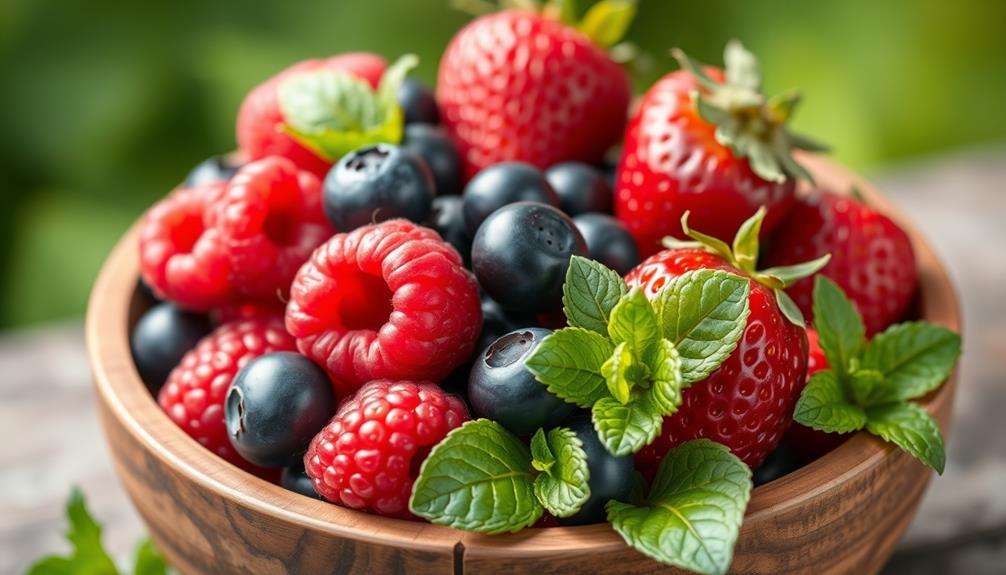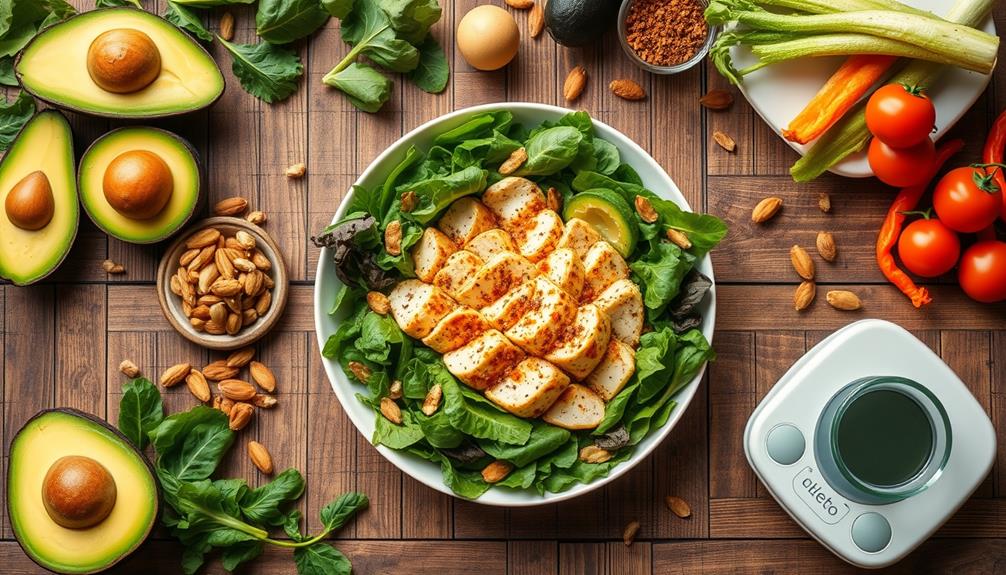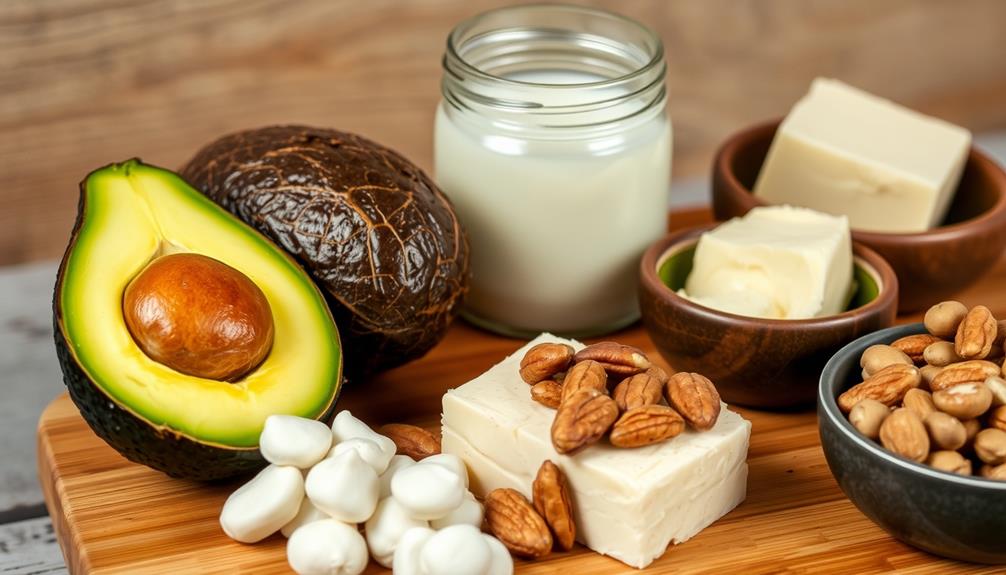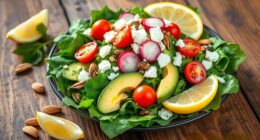To add more fat to your keto diet, simply incorporate high-fat foods like avocados, coconut oil, and fatty cuts of meat into your meals. Use olive oil for cooking and dressings, and snack on nuts or seeds for a quick fat boost. Don't forget full-fat dairy options like cheese and sour cream, which also help increase your fat intake. Try adding heavy cream or nut butters to your smoothies and desserts for extra creaminess. With these simple adjustments, you'll enhance both flavor and nutrition, keeping your energy up and cravings at bay—discover even more strategies to elevate your fat intake.
Key Takeaways
- Incorporate healthy oils like olive oil and coconut oil into cooking and salads to boost fat intake.
- Add full-fat dairy products such as cheese and sour cream to meals for increased fat without raising carbs.
- Create fat bombs using cream cheese, nut butters, and coconut oil for quick energy and to satisfy cravings.
- Enrich smoothies with heavy cream, full-fat yogurt, or avocado for added creaminess and healthy fats.
- Snack on nuts and seeds to increase fat content while providing a crunchy texture and flavor.
Importance of Fat on Keto
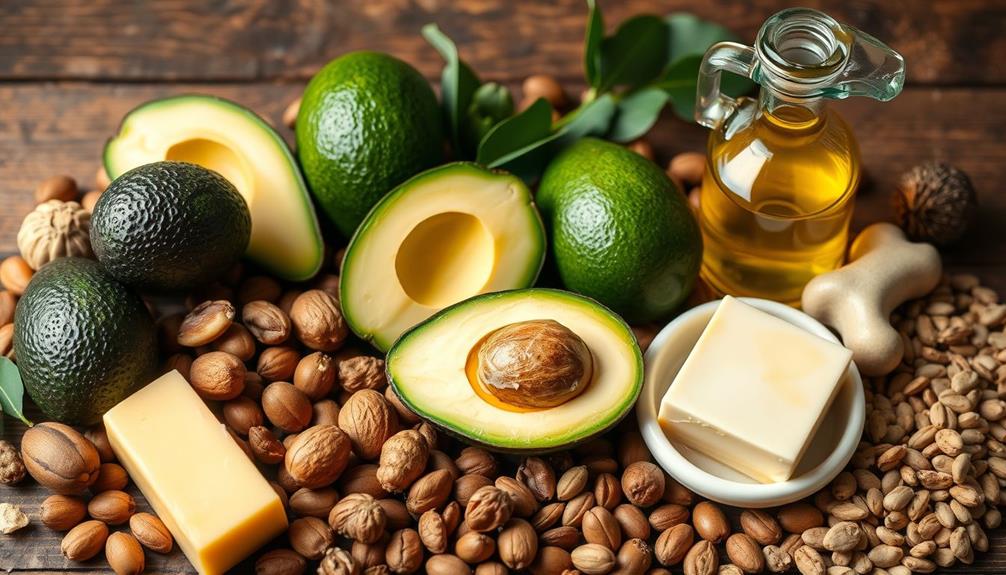
When diving into the keto diet, understanding the importance of fat is essential for your success. The ketogenic diet requires you to consume approximately 70-80% of your calories from fat to maintain ketosis, where your body burns fat for fuel instead of carbohydrates.
Incorporating healthy fats into your meals can also play a role in better blood sugar management, which is especially beneficial if you're dealing with insulin resistance or type 2 diabetes. Adequate fat intake not only helps suppress hunger levels but also makes sticking to the diet easier, leading to significant weight loss.
You should aim to consume enough fat by choosing various sources of fat like avocados, nuts, and olive oil. These options not only enhance the nutrient profile of your diet but also promote better overall health outcomes.
Barriers to Fat Consumption

You might find it challenging to fully embrace a high-fat ketogenic diet due to cultural norms that favor low-fat meals.
Persistent myths about the dangers of fat can also create mental roadblocks, making it hard to shift your mindset.
Additionally, many people are unaware of the importance of incorporating healthy fats for ideal health and successful dietary changes, which can be addressed through effective strategies for weight loss.
Plus, social settings often feature low-fat, high-carb options, complicating your ability to stick to your fat-focused goals.
Cultural Norms Resistance
Resistance to cultural norms can greatly hinder the adoption of a high-fat keto diet. Many cultural beliefs prioritize low-fat and high-carb diets, making the shift to a high-fat approach feel unfamiliar or radical. This resistance stems from long-standing myths about dietary fat being harmful, despite emerging evidence showcasing its health benefits.
Understanding the importance of budgeting for food choices can help you allocate resources effectively to support your keto lifestyle.
When you find yourself in social settings, like family gatherings or dining out, you'll often encounter carb-heavy meals that can challenge your adherence to a high-fat keto diet. This environment may lead to discomfort or awkwardness, pushing you to revert to traditional diets.
The shift from a carb-heavy diet to a high-fat keto diet requires significant behavioral change, which can be overwhelming.
Furthermore, negative perceptions about fat can deter you from fully committing to the keto lifestyle. If you struggle to maintain the necessary macronutrient ratios for ketosis, it's often due to this cultural resistance.
To succeed, you'll need to confront these perceptions and embrace the high-fat keto diet, recognizing that altering your mindset is an essential step toward achieving lasting health benefits.
Myths About Fat
Cultural norms and misconceptions about dietary fat often create significant barriers to adopting a high-fat ketogenic diet. Many people still cling to the belief that fats lead to weight gain, despite evidence showing that a high-fat diet can enhance satiety and support weight loss. This misinformation can make shifting from low-fat diets feel radical and intimidating.
Understanding the role of healthy fats, such as those found in vital oils like eucalyptus oil, which can aid in respiratory health, may help alter perceptions about fat consumption.
Moreover, misunderstandings about saturated fats persist. While these fats were once demonized, recent research suggests they may not be as harmful as previously thought when consumed in moderation. It's important to differentiate between healthy saturated fats and unhealthy trans fats, as the latter can indeed pose health risks.
You might also experience initial discomfort when increasing your fat intake. This is a normal part of your body's adaptation to using fat as a primary fuel source. If you push through this phase, you'll likely find that your energy levels stabilize and cravings diminish.
Overcoming these myths is vital for embracing a keto diet fully. Once you do, you'll reveal the numerous benefits of a high-fat lifestyle, paving the way for sustained health and satisfaction.
Social Setting Challenges
Maneuvering social settings while adhering to a high-fat ketogenic diet can be quite challenging. You might find it tough to locate healthy sources of high-fat foods to eat, especially since cultural norms often favor low-fat and high-carb options. This can lead to temptation when processed foods dominate the table, making it harder to stick to a high-fat diet.
Explaining your dietary choices can also be a hurdle. Friends and family may not understand why you're altering from a carb-heavy diet, leading to potential misunderstandings or judgment.
Here's a quick look at common social setting challenges you might face:
| Challenge | Impact on Diet | Possible Solutions |
|---|---|---|
| Low-fat options available | Temptation to indulge | Bring your own high-fat snacks |
| Misunderstanding from others | Social pressure | Prepare to explain your choices |
| Lack of suitable menu items | Limited options | Suggest restaurants with keto-friendly meals |
| Uncomfortable discussions | Feelings of isolation | Find a support group or keto friends |
Navigating these challenges can be tough, but awareness and preparation can help you maintain your commitment to a high-fat lifestyle.
Types and Sources of Fat

When you're adding more fat to your keto diet, it's crucial to know the different types and sources available.
Incorporating healthy fats can also enhance your overall well-being, as certain fats, like those from nuts and seeds, provide beneficial nutrients and support various bodily functions.
You'll want to focus on incorporating healthy saturated and unsaturated fats while steering clear of harmful trans fats.
Understanding these options will help you make informed choices that support your health goals, much like selecting the right carrier oils for essential oil rollers.
Saturated Fat Sources
Elevate your keto diet by incorporating a variety of saturated fat sources, which are essential for meeting your high-fat macronutrient goals. Saturated fats, found in foods like butter, fatty cuts of meat, and full-fat dairy, can help you achieve the recommended 70-80% fat intake critical for a successful keto lifestyle.
Additionally, consider the balance of your overall health and dietary needs, as certain fats can also play a role in cold medications overview and other health aspects.
Coconut oil is another fantastic option, offering high-fat content and unique flavor for your dishes. Recent studies indicate that moderate consumption of saturated fats, especially from grass-fed butter and coconut products, may not greatly increase heart disease risk as once believed.
In addition to providing fats, these sources also deliver essential nutrients. Eggs, for example, contribute not only saturated fat but also protein and important vitamins.
Full-fat cheese is another delicious way to enjoy saturated fats while getting calcium.
Healthy Unsaturated Fats
Healthy unsaturated fats play an essential role in your keto diet, offering delicious options that can enhance both flavor and nutrition.
These fats are divided into monounsaturated and polyunsaturated fats, which provide numerous health benefits. Monounsaturated fats, found in foods like avocados and olive oil, can lower LDL cholesterol while maintaining HDL levels, promoting heart health.
Additionally, understanding the impact of various brewing methods on caffeine content can help you enjoy your coffee in a healthier way while on a keto diet.
Polyunsaturated fats include essential omega-3 and omega-6 fatty acids, which you can find in sources like fatty fish, walnuts, and flaxseeds.
Incorporating these healthy unsaturated fats not only boosts your nutrient intake but also helps reduce inflammation and improve brain function. Adding these fats to your meals can enhance satiety, making it easier to maintain a high-fat intake while sticking to the low-carb guidelines of the keto diet.
Use olive oil for cooking or drizzling over salads, snack on a handful of nuts, or enjoy fatty fish like salmon a couple of times a week.
Avoiding Trans Fats
Trans fats are one of the most harmful types of fat you can consume, and avoiding them is essential for your health on a keto diet. These artificially created fats, often found in processed snacks and fried foods, are linked to an increased risk of heart disease. They raise your LDL cholesterol levels while lowering HDL cholesterol, which is detrimental to your overall health.
Instead of relying on processed foods, consider incorporating more wholesome options like butter, which can enhance flavor and provide healthy fats when consumed in moderation butter health considerations.
To steer clear of trans fats, read nutrition labels carefully. While the FDA banned partially hydrogenated oils in 2015, some products may still contain natural trans fats in small amounts from meat and dairy.
Instead of reaching for those processed snacks, focus on whole foods that offer healthier fat sources. Incorporate avocados, nuts, and olive oil into your meals to boost your fat intake without the harmful effects of trans fats.
Strategies to Increase Fat Intake

Adding more fat to your keto diet can be both simple and delicious. Start by incorporating high-fat ingredients like coconut oil and avocado oil into your meals and snacks. These healthy fats help you maintain the keto macro ratio of 70-80% calories from fat while keeping your carbohydrate intake low.
Additionally, consider enjoying herbal teas like rooibos or yerba mate, which can complement your diet with their unique health benefits, including Rooibos benefits such as being rich in antioxidants.
You can also whip up some convenient fat bombs using cream cheese, nut butters, and coconut oil. These tasty snacks provide quick energy and are perfect for satisfying your cravings.
If you enjoy smoothies, boost their fat content by blending in heavy cream, full-fat yogurt, or nut butters for added creaminess.
When it comes to dairy, always choose full-fat options like cheese, sour cream, and heavy cream. This helps increase your fat consumption without markedly raising your carb intake.
To maximize your healthy fat intake at each meal, drizzle olive oil over roasted vegetables and sprinkle nuts or seeds on salads. By using multiple fat sources, you'll not only enjoy extra fat but also enhance the flavor of your dishes.
Embrace these strategies, and you'll effortlessly increase your fat intake while sticking to your keto goals!
Incorporating Fats Into Meals
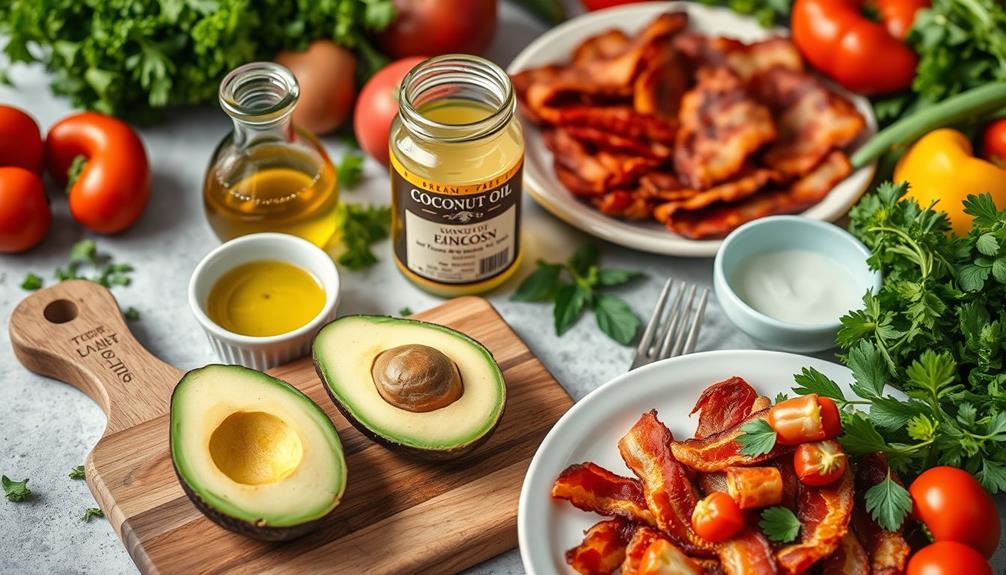
Incorporating fats into your meals can elevate not just the nutritional value but also the flavor of your dishes. Start by using healthy oils like extra virgin olive oil or coconut oil when you sauté vegetables, roast meats, or dress salads. This technique not only enhances taste but also boosts your fat intake.
Additionally, ensuring a well-rounded diet with various fats is essential for overall health, similar to how proper care for pets involves understanding their dietary needs, such as providing high-quality pellets for hamsters proper diet for hamsters.
Avocado is another fantastic way to incorporate fats. You can add sliced avocado to salads and sandwiches or blend it into your meals for a creamy texture and healthy monounsaturated fats.
Don't forget about full-fat dairy products, such as heavy cream, full-fat cheese, and sour cream, which can enrich your sauces, soups, and side dishes, markedly increasing fat content.
To make the most of your low-carb vegetables, create high-fat dips by mixing healthy oils and full-fat ingredients like cream cheese or mayonnaise with herbs and spices. This not only enhances flavor but also contributes to your fat intake.
Finally, consider adding nuts and seeds as toppings or snacks. Pecans or chia seeds can easily increase the fat content of your meals while adding a satisfying crunch.
Enjoy these strategies to maximize fats in your keto diet!
Smoothies and Desserts

Smoothies and desserts can be deliciously satisfying while fitting perfectly into your keto lifestyle. You can greatly boost the fat content of your smoothies by incorporating heavy cream, full-fat yogurt, or nut butters. These additions keep carbs low while enhancing creaminess.
Opt for low-carb fruits like avocados or berries to elevate both the texture and nutritional value without exceeding your carb limits. For a tropical twist, try adding shredded coconut or coconut milk, which provide healthy fats and MCTs.
When it comes to dessert, indulge in keto-friendly options like chocolate mousse made with heavy cream and unsweetened cocoa powder. This rich treat aligns perfectly with your macronutrient goals.
Additionally, you can whip up fat bombs by mixing coconut oil, nut butter, and flavorings like cocoa or vanilla. These high-fat snacks can satisfy your sweet cravings while keeping carbs at bay.
Avocado Usage

Since avocados are packed with healthy monounsaturated fats, they make a fantastic addition to your keto meals. Each medium avocado provides around 15 grams of healthy fat and only about 3 grams of net carbs, making them a perfect low-carb option for your keto diet.
You can easily incorporate avocados into your meals by adding them to salads, blending them into smoothies, or enjoying them as guacamole with low-carb veggies.
Avocado oil is another great way to enjoy the benefits of avocados. With a high smoke point, it's perfect for sautéing or as a base for homemade salad dressings. This versatility allows you to increase your healthy fat intake effortlessly.
Additionally, the fiber content in avocados—approximately 10 grams per medium fruit—supports digestion and promotes satiety. This means you'll feel fuller longer, helping to curb hunger while you follow a high-fat diet.
Frequently Asked Questions
How Do I Add Good Fat to My Keto Diet?
To add good fat to your keto diet, incorporate healthy oils in cooking, snack on nuts and seeds, enjoy full-fat dairy, choose fatty meats, and try fat bombs for a satisfying treat.
What Happens if I Don't Eat Enough Fat on Keto?
Skipping out on fat in your keto diet is like driving a car without fuel. You'll feel hungry, tired, and struggle to maintain ketosis, making it harder to stay on track and reach your goals.
What Foods Are High in Fat for Keto?
If you're looking for high-fat foods for keto, try fatty fish like salmon, avocados, nuts, seeds, full-fat dairy, and healthy oils. These options will help you meet your fat intake goals effectively.
How Can I Increase My Fat Burn in Ketosis?
To increase your fat burn in ketosis, focus on consuming healthy fats, engage in regular moderate exercise, stay hydrated, and consider incorporating MCTs. This combo helps optimize fat utilization for energy and enhances ketone production.
Conclusion
By embracing the importance of fat in your keto diet, you're not just fueling your body; you're also indulging in delicious flavors that enhance your meals. Don't let barriers hold you back—explore various sources and strategies to effortlessly increase your fat intake. As you blend fats into your dishes and savor creamy avocados, remember: your journey to better health can be both enjoyable and satisfying. After all, isn't life too short to skimp on flavor?

